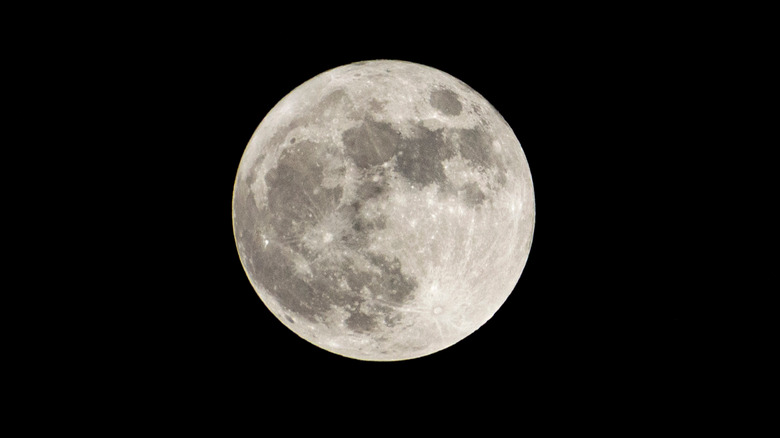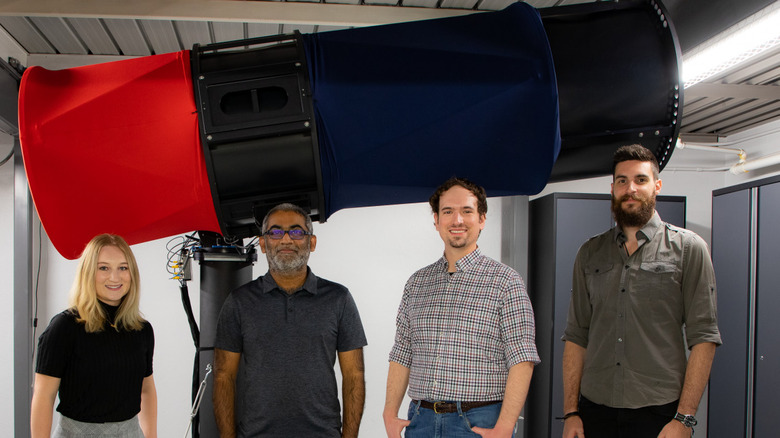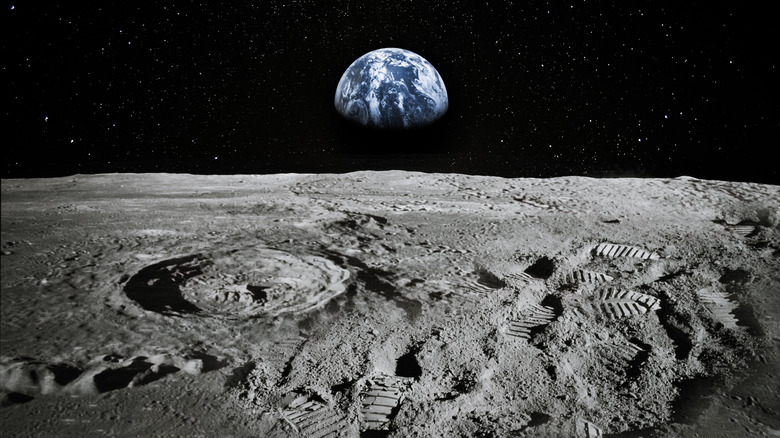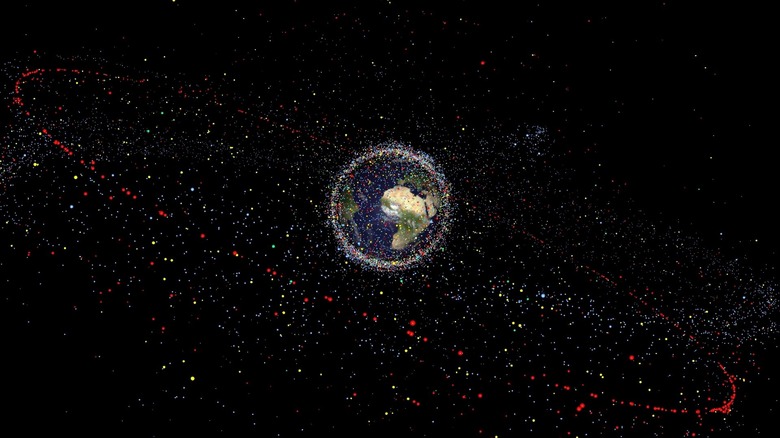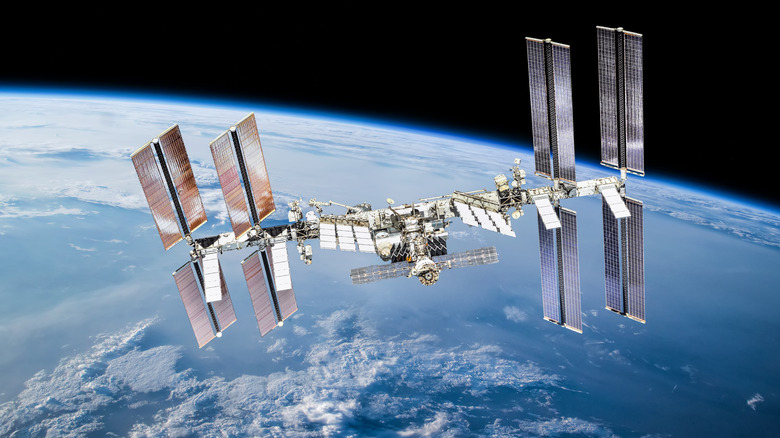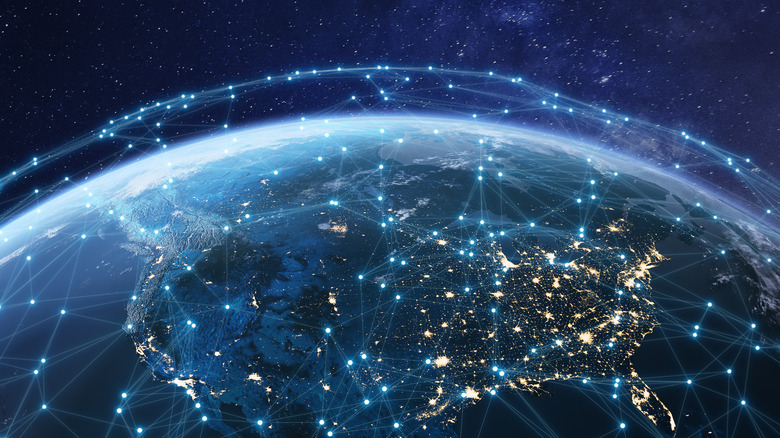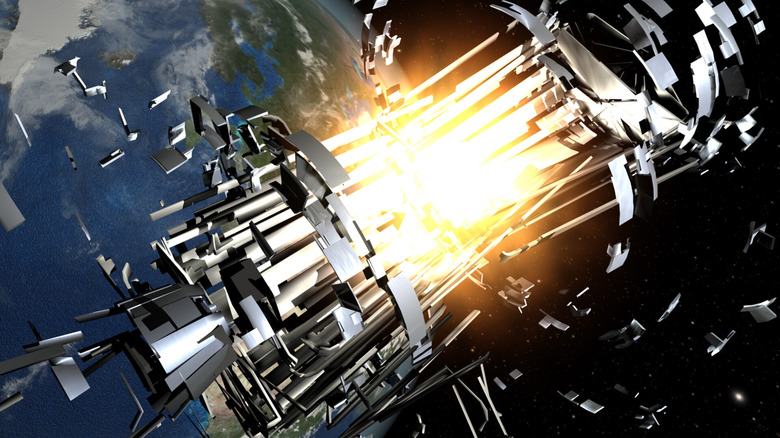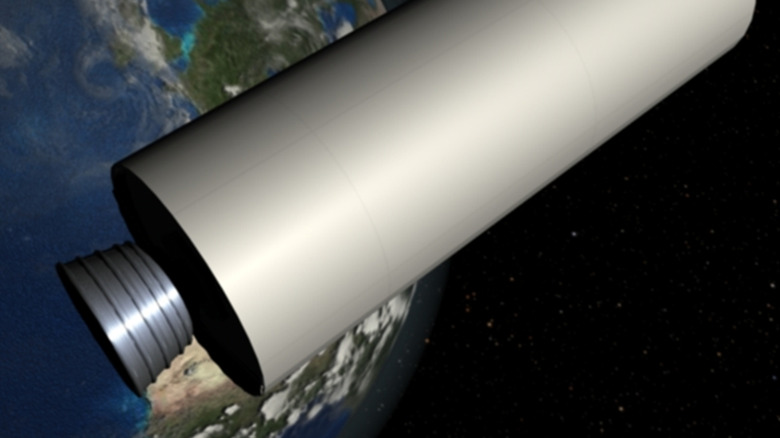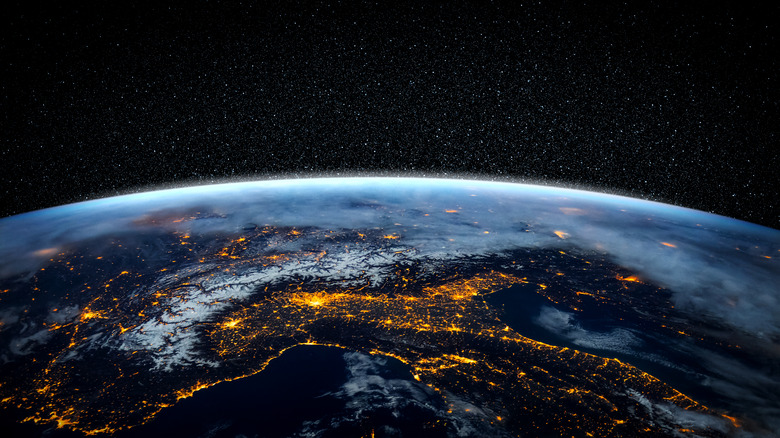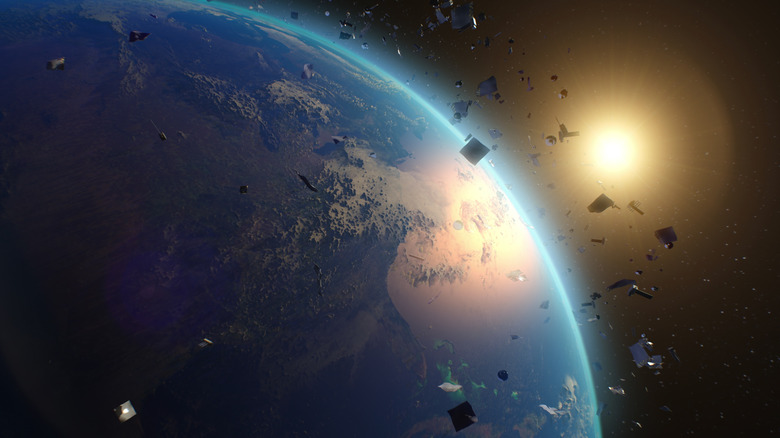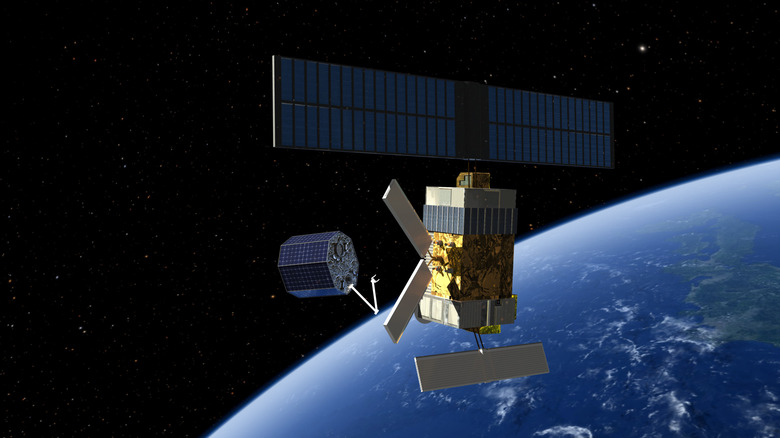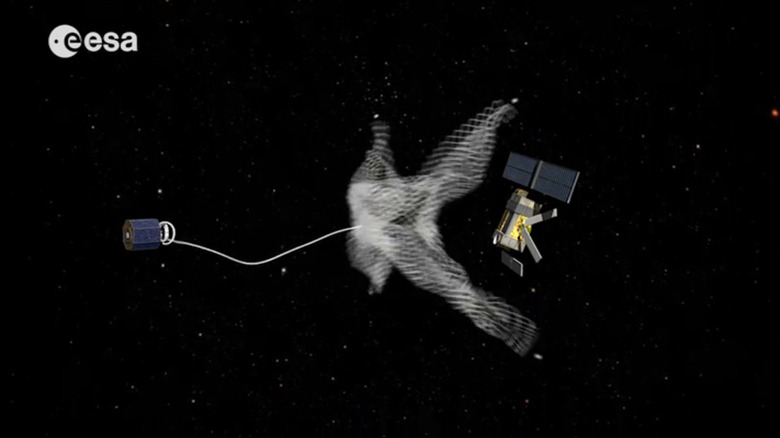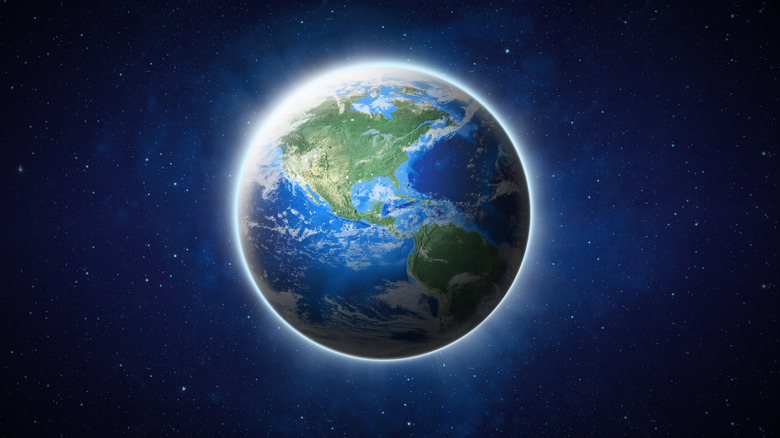Expert Reveals What The Space Junk Crash Will Do To The Moon Today
The moon will be receiving an unexpected visitor today, March 4, 2022, when a piece of space debris will slam into it. The debris is left over from human space exploration, and it's a vivid example of the problem of space junk. There are no trash cans in space, so when something breaks or is no longer needed, often it's just left where it falls to continue orbiting Earth. So in the space all around our planet, bits of old satellites and parts of rockets, along with millions of smaller bits and bobs, are floating in an ever-growing cloud of space junk. With no atmosphere to erode it away, much of this junk will stay in orbit for decades or even longer, and continue piling up as we discard more and more hardware into space. And if that weren't worrying enough, much of this debris is traveling at high speeds, making it even more dangerous.
If you've seen the movie "Gravity," where the opening sequence shows a crew trying to fix the Hubble Space Telescope being bombarded by tiny, fast-moving pieces of junk, then you have an idea of just how dangerous space debris can be. To learn more about the junk that's about to hit the moon, and about the bigger problem of debris which could cause major problems for space exploration down the line, we got in contact with Vishnu Reddy, an associate professor at the University of Arizona. Reddy and his team were the experts who first identified the junk about to hit the moon as part of their work in the Space Domain Awareness lab.
What's hitting the moon?
When astronomers first spotted a piece of junk on course to hit the moon, people originally thought it was part of a SpaceX booster. But Reddy's lab observed the junk and took a spectrum of it, which shows its composition, and compared that to both SpaceX and Chinese rockets. They found that the bit of rocket wasn't actually from SpaceX, but was rather a part of a Long March 3C rocket from China's Chang'e 5-T1 mission, which was launched in 2014.
Now that piece of rocket is impacting the moon today, and it will hit hard enough to leave a lasting mark. "The impact will happen at 12:26 pm GMT on March 04, 2022," Reddy said. "The booster will impact at a 76-degree angle and given its velocity of ~2.5 km/sec and a mass of ~4 tons, it will create a crater between 20-30 meters and a few meters in depth."
That's a significant crater, which will be wide enough to be visible from orbit. Reddy says that craft like NASA's Lunar Reconnaissance Orbiter or the Indian Space Research Organisation's Chandrayaan-2 craft, both of which orbit the moon, will be able to see the crater with their on-board cameras.
There's no need to panic about this impact, as Reddy assures us that the collision won't be a serious problem. But it's worth considering that because of a discarded piece of junk, we'll be leaving a scar on the face of the moon. The collision is predicted to occur on the far side of the moon, in or near a larger impact crater called the Hertzsprung crater. The moon is pocked with marks from impacts with asteroids or meteorites, and soon it will have one more, caused by humans.
How common is it for junk to hit the moon?
At the moment, it's pretty rare for debris to hit the moon. And it's definitely rare to spot a piece of debris on its way to the moon, as happened in this case. "Unintentional impact of debris with the Moon where we have prior warning, is relatively rare," Reddy said. "We have missions that go to the Moon that crash into the Moon because of some malfunction or by design, but it is rare to find something that is a piece of debris about to hit the Moon ahead of time."
However, Reddy predicts that the problem of space debris impacting the moon could get worse in future. "We estimate between 25-50 payloads to the moon in the next decade, so the chances of collisions like this will only increase," he said.
Because the moon lacks an atmosphere, it's especially vulnerable to space debris impacts. Some debris can burn up in the atmosphere of Earth, but that can't happen on the moon. So if something is heading toward the moon, it will likely cause an impact. With plans from NASA and other space agencies to explore the moon more in the next decades, and even set up a long-term base for humans there (via NASA), we need to think about what danger such impacts could pose to future explorers.
The need for moon monitoring
One of the worrying things about the problem of space debris is that there are large areas of space for which we have few tools monitoring the debris problem.
Future impacts on the moon, like the one happening today, can be predicted but only if researchers like Reddy continue to monitor debris near the moon. "We are getting ahead of this problem by tracking junk around the Moon," he said. "We currently track [around] 200 objects in cislunar space."
At the Space Domain Awareness lab, Reddy and his colleagues use a telescope called RAPTORS, based at the University of Arizona, to observe debris around the moon up close. But it's not an easy job.
"This task is extremely challenging because [of] the distance to the Moon and the volume of space to be covered," Reddy explained. Compared to the area monitored by the U.S. government, which covers up to geostationary orbit, the area beyond this and up to the moon is much larger. "The volume of space to be scanned for cislunar objects is 1,728 times that of the space inside the geostationary belt. So, the area to cover is vast."
Not only is the area to watch around the moon extremely large, but also, because it's so far away, the objects being observed are very faint. That makes the job even harder.
How bad is the broader problem of debris?
It's not only the moon which suffers from the problem of space debris. In fact, there is a tremendous amount of manmade material all around our planet. Current estimates from the European Space Agency, updated in March 2022, show that there is a total mass of more than 9,800 tonnes of space objects in Earth orbit, consisting of around 7,810 satellites still in space from the 12,720 satellites placed into orbit by over 6,000 rocket launches since 1957.
These aren't all junk, as many of these satellites –- around 5,200 –- are still functioning. However, others are already nonfunctional, and all will end their lives eventually. Some will be responsibly deorbited, by lowering their altitude until they burn up in Earth's atmosphere. But many others will be left to float where they fail, clogging up the space around our planet with trash.
In total, Reddy says, there are a huge number of objects floating around that are junk. "The US government tracks [more than] 22,000 objects larger than a grapefruit, and the expectation is that there are between 300,000-600,000 objects larger than a golf ball around the Earth," he said.
These objects are tracked by organizations like the U.S. Space Force. But this tracking only covers a limited area of space, up until geostationary orbit which is around 36,000 km from the surface. "Beyond that, there is no one tracking objects except for our group at the University of Arizona," Reddy said.
The threat of space debris
So there's a whole lot of junk floating around in space. Is that a problem? The answer, unfortunately, is very much yes. Space debris can threaten scientific research, human space exploration, and even the satellites which enable everyday functions that we take for granted like communications or GPS.
In some of the most dramatic examples of the problem of debris, the International Space Station frequently has to move to avoid large chunks of debris hitting it and threatening the astronauts on board (via The Guardian). This problem was exacerbated when a Russian weapons test blew up a satellite in 2021, creating a cloud of debris that forced the astronauts on the ISS to take shelter for several hours (via Vox).
And satellites are at risk too. We're dependent on satellites for everything from finding our way using the maps on our phones to communicating across the globe. Many satellites work in groups which makes them more robust against failure, so if one satellite fails then the others can continue working. But in the long term, if launching and operating satellites becomes too difficult and expensive, we may have to rethink how we use satellites.
Where the junk comes from
If you look at figures of the number of satellite launches since the beginning of space exploration in the 1950s — as documented by Space Launch Report – you can see that the numbers go up and up from a handful per year in the early days to hundreds per year now. And that will only increase in the future.
As more small satellites are launched, experts are worried that these could pose a threat to missions like human space exploration or research missions, because the satellites do not have propulsion systems so they can't avoid collisions or perform disposal maneuvers like adjusting their altitude to burn up in the atmosphere (via ESA Space Debris Office).
If two satellites collide with each other, they can create thousands of smaller pieces of debris that get spread over a large area. According to ESA, the first in-orbit collision occurred in 2009 and generated more than 2,300 fragments. In addition to this problem, there is also the debris caused by the explosion of spacecraft or the upper stages of rockets. Since 1961, there have been more than 500 "fragmentation events" in orbit which also generated thousands of pieces of debris.
The ultimate threat: The Kessler effect
These are only some examples of the problems caused by space debris. As we continue launching more objects into Earth's orbit, and these objects continue to collide with each other, the problem will just get worse. And there's a terrifying worst-case scenario of what that could cause, known as Kessler syndrome (also known as the Kessler effect).
The idea of the Kessler effect, named for NASA scientist Donald J. Kessler who came up with the concept in the 1970s, is that debris could become so common that it could reach a critical mass (via National Space Centre). If enough debris is in orbit, the likelihood of bits of debris colliding goes up. And each collision causes more debris, making the problem worse. Eventually, we could end up in a situation where there is so much debris that space exploration becomes difficult or even impossible. There would be so much debris around the planet that we couldn't launch rockets safely, and we'd be trapped on Earth with no way to explore the space beyond.
Kessler effect and the moon
Reddy raised this as a possibility for the long-term dangers posed by space junk. "Debris around the Earth can lead to what is called the Kessler effect," he said, "Think of the opening scene from the movie 'Gravity' where you have a Chinese satellite explode, and the debris from it hit the space shuttle and the Hubble Space Telescope and the debris from that hit other satellites ... a cascading debris generation scenario where you have an uncontrolled chain reaction."
When it comes to moon exploration, this problem is particularly acute. It is theoretically possible to remove some debris from around Earth, and some of it will burn up in the atmosphere. When it comes to the moon, however, that won't work. "We want to avoid that situation around the Moon because on Earth, debris can be removed from low Earth orbit due to the expansion of the atmosphere tied to solar activity," Reddy said. "There is no atmosphere around the Moon ... so stuff will stick around for a long time."
Why the problem is so bad
Given the potential seriousness of the space debris issue, you might wonder why the situation has been allowed to get so bad. There are several reasons for this -– one being that, like the problem of climate change, it's an issue which seems far away and too big to tackle, so people tend to put it out of their minds. It's also an issue that would require international cooperation to address, and that is particularly difficult to arrange.
At the very least, you might hope that we are taking steps to stop the problem from getting any worse. But it's not as simple as that. That's because no single organization is responsible for overseeing space debris, and when a piece of debris does cause problems, it's not obvious where it came from. It's hard to assign responsibility when there's no group which is empowered to hold others to account.
Taking responsibility for junk
Just think of the junk that's hitting the moon today. People thought it was a SpaceX booster at first, and it was only discovered to be a Chinese booster when Reddy's group observed it carefully. That's because debris isn't labeled, so without time-consuming observations, it's impossible to know where any piece of debris came from.
Not to mention the difficulty in even spotting debris near the moon in the first place. It's "very challenging" to know the origin of a piece of debris, Reddy said, because "remember it is hard to detect these things in the first place, let alone know what they are and who they belong to. Unless you keep track of something since they are launched, there is no way to attribute something to a specific nation. It takes a lot of detective work to characterize debris and associate it with a specific launch."
Even when a piece of debris is identified, like the booster impacting the moon, the government or organization responsible might not acknowledge it. In the case of the booster Reddy's group identified as being of Chinese origin, the Chinese government denied it was theirs, despite NASA agreeing with the conclusions of Reddy's group.
What can be done?
So with all these dangers posed by space debris, is there any hope of a solution? Thankfully, there are people working on this issue, and it's a problem that people in the space community are very aware of. If we were able to take action now, we could prevent the problem from becoming worse and triggering a worst-case scenario like the Kessler effect.
There are two prongs to addressing the current space debris problem. The first piece of the puzzle is to track the debris that currently exists and keep watch over exactly how much junk is out there and what it could impact. The second approach is to find ways to clear up some of that junk and to make sure the problem doesn't get any worse.
As well as space agencies like NASA and ESA tracking debris around Earth generally, groups like Reddy's want to focus on identifying the debris around the moon specifically.
"Our goal is to first create a catalog of cislunar objects, so we have an inventory of objects," Reddy said. "Then we want to keep track of what is there and add to it when we have new launches, so the catalog is up to date. This will give us a strong foundation to build upon and avoid the kind of mess we have with space debris around the Earth."
With such a catalog, we could predict any future impacts like the one happening today, and be on the lookout for debris which could cause problems for future moon missions.
Cleaning up debris
Other organizations are working on plans for what to do with debris once it has been identified. The European Space Agency is planning a space claw which could capture pieces of junk and move them into a lower orbit, so they would burn up in the atmosphere (via Science). That's tricky though, because debris comes in all sorts of shapes and sizes, and isn't easy to grapple. It can also be rotating which makes it even harder to grab.
Other ideas involve using nets and harpoons to capture debris (via The Verge), which has the advantage of being able to grab rotating pieces. Or there is the idea of using ground-based lasers to identify smaller pieces of debris and push them out of the way of upcoming impacts (via IEEE). Another concept is to use magnets to manipulate metallic pieces of debris to make them easier to clean up (via the University of Utah).
Tragedy of the commons
There are lots of great ideas for cleaning up the debris that already exists, but we need funding and political will to put them into practice. And, perhaps even more importantly, we need international cooperation to stop the problem from getting worse in future, to make sure that those launching space missions also have a plan for responsibly disposing of their hardware when it's no longer needed.
The problem of space debris is what is called a tragedy of the commons, where there is a problem which affects everyone but individuals are not well motivated to address it (via Scientific American). The entirety of humankind benefits from access to space, but this access will be limited in the future if we don't act as one to protect it and to deal with the junk that we've already created.
As NASA writes, "Space junk is no one countries' responsibility, but the responsibility of every spacefaring country. The problem of managing space debris is both an international challenge and an opportunity to preserve the space environment for future space exploration missions."
